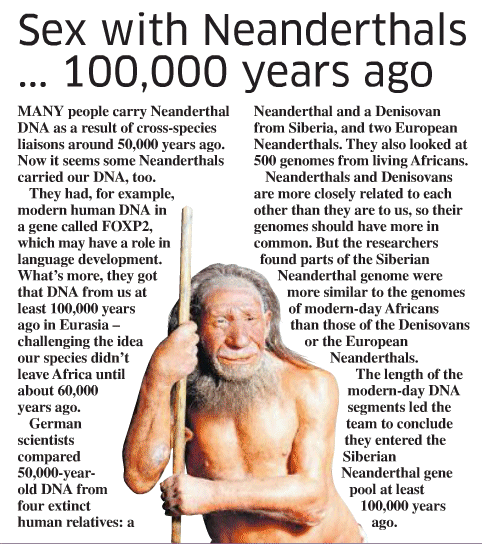THE HUMAN STORY
|
Six million years ago,a few bands of apes in the shrinking African forest
were running out of luck...then some of them began to walk upright,and their
descendants took over the world.This is the story of an extraordinary
ape.
Ann and Patrick Fullick
HUMANS could justifiably be called the most successful of
all living organisms. We have colonised every continent, and our technology,
cultures, communication skills and use of world resources make us appear
very different from the rest of the animal world. Yet we have a remarkable
biological similarity to our nearest living relatives, the
chimpanzees.
No one knows for certain when our lines diverged - the evidence is hard to
find and difficult to interpret, so models of human evolution are constantly
disputed and altered (see Box 2). In 1859,
Charles Darwin's book On the
Origin of Species made the idea of ape ancestry a compelling scientific
hypothesis. Since then, many hundreds of fossils and many tens of thousands
of stone tools have been found to prove that Darwin's theory applies to humans.
This prehistoric evidence - as well as comparisons between living humans
and other animals, and the study of human culture - tell us more each day
about the path we trod between the African forest and modern life.
Humans are mammals, just like horses, mice and dolphins. More
precisely, we are primates, a group of mammals that first appeared
more than 60 million years ago and which includes the lemurs, monkeys and
apes. Primates are especially good at surviving in the trees. Climbing and
running through branches requires dexterity, good eyesight and excellent
judgment - a fall from a tree can be fatal, and food trees and insects must
be discovered, remembered, gathered and caught. Primates are well endowed
with brains. They can manipulate food items with their hands. They generally
give birth to only one offspring at a time, and consequently have good maternal
care, which ensures a good chance that at least a couple of the low number
of offspring survive to reproductive age. The primates are long - lived by
comparison with other mammals of similar size. Chimpanzees regularly reach
their forties in captivity, while the much bigger horse is old in its
twenties.
The animal in us all Life in the trees
PRIMATES are often social animals and communicate by a number of facial
expressions and barks or grunts. Those that live in social groups often have
strict hierarchies of social status. In some species females are dominant,
in others the males are obeyed. Males which defend groups against predators
are often larger than the females, and have large canine teeth - the pointed
teeth third from the midline. But the primate way of life is also relatively
free from predators, and the rich diet from the trees has given primates
the spare time to interact with each other. Many hours of the day are spent
grooming, making friends and engaging in social intrigues.
From 25 million years ago until about 5 million years ago
there were many species of apes. This was the age of the apes. The climate
in much of Africa and Asia was warm and humid, and forests grew throughout
the semitropical and tropical parts of the Old World.
But by about 7 million years ago, the climate began to change. Temperatures
dropped, the forests began to recede, and the apes became fewer and isolated.
Savannah grasslands and scrub became more common, and led to an increase
in the number of monkeys.
The African apes, the gorilla and chimpanzee, are our closest
relatives. Their skeletons and ours have every bone in common, and the genetic
distance between humans and chimps, measured by similarities in proteins,
is less than 1 per cent.
That small difference disguises big changes. While we can recognise our ape
ancestry in our blood, bodies, hands, expressions and behaviour, prehistory
must try to explain how, when and why human beings began to walk upright
and have a skeleton that is well adapted for this style of locomotion.
Many adaptations are needed for this, the foot is at a right angle to the
leg and has a heel, the pelvis is rounded to carry the weight of the abdominal
organs, the spine is curved into an S-shape to carry the weight of the head
and arms, and it is the base of the skull that joins to the spine, not the
back of the skull as with most four-legged animals.
Other differences that must be explained are why we are (at
least most of us) relatively hairless. Humans have opposable
thumbs and can grip objects with precision against the first and second
fingers. Our faces are flattened, unlike the apes, that have protruding jaws.
The spurt of development seen during puberty in young human beings is not
seen in other primates-so perhaps stroppy adolescents are a purely human
phenomenon.
Last but certainly not least, we have a greatly expanded brain which enables
us to develop and use tools of quite amazing complexity. The size and structure
of the human brain also makes possible the construction and use of language,
not merely to communicate simple biological drives such as sexual receptiveness,
hunger and aggression but also complex ideas, plans and philosophies. Human
culture and the use of rituals to mark the various stages of life are unique
in the animal world.
| 1: Interpreting the evidence FOSSILS are scarce, and even the tiniest fragment of bone most be subjected to detailed examination. A tossil jaw and teeth can give an idea of the lower face. |
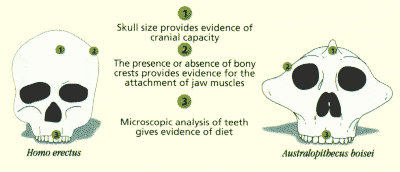 |
| The shape, size and wear on the teeth, including microscopic analysis, can indicate the type of diet eaten. A pelvis or limb hone can give evidence of weight and height, and indicate posture and the efficiency of opright walking. Ridges and bumps on bones are often places where muscles are attached, giving an indication ot the build of our ancestors, while marks on the inside of skulls can even give an idea of the structure of the brain. | |
The "missing link" species between apes and humans
has yet to be found. But the likely time to look would be about 6 million
years ago, in Africa. Our closest relatives still live in Africa, and fossil
hominids there date back at least 2.5 million years earlier than elsewhere.
Chimps and the other apes do not walk upright except occasionally. So it
is probable that our common ancestor also lived on all fours. Some time between
6 million years ago and about 4.5 million years ago, the age of the oldest
biped yet found, descendants of the common ancestor began to walk upright.
Upright walking is usually accepted as the first real step
made by the "hominids". This group includes all living people today,
all their ancestors back to the time of upright walking, and several species
of fossil bipeds who later died out.
Most of the early hominids belonged to the genus Austrolopithecus,
or "southern ape". The earliest is older than 4 million years, and over the
next 3 million years a number of different species of australopithecines
evolved, some of which were almost certainly our ancestors, while others
became extinct.
Common ancestors Close relatives
EVEN the earliest australopithecines could walk upright,
though there are some features of leg bones from the oldest specimens which
have led some anatomists to suggest that they could still scamper up a tree
for food or for protection.
One of the best known of all early hominid finds is a 3-million-year-old
australopithecine called "Lucy", who lived more than a million years
after the first known upright walker, but in almost exactly the same spot.
She got her name because her discoverers, led by Donald Johanson, now at
the Institute for Human Origins, were listening to the famous Beatles tune
Lucy in the Sky with Diamonds at the time. She was discovered in 1974
at Afar Hadar in Ethiopia at the northern end of the East African rift valley.
Lucy was about 1.07 metres tall and probably weighed only 30 kilograms-less
than half the weight of a typical human female.
It is clear from Lucy's pelvis that she was an accomplished
walker, just like us. Her brain, however, was no larger than a chimpanzee's.
So being brainy was not the crucial factor that first distinguished us from
the apes, it was upright walking. But what advantage did this give our ancestors
over their four-legged contemporaries?
Peter Wheeler of the University of Liverpool has suggested that bipedalism
evolved as an adaptation for searching for food in hot, equatorial latitudes.
Most African mammals find it very hard to keep cool in the heat of the day
because they expose a large surface area to the overhead sun. They overcome
this by resting in the shade during the day and only hunting early in the
morning and in the evening. The brain in particular is difficult to keep
cool, and the larger the brain, the hotter it becomes.
| 2: Controversial theories of human
evolution FOSSILS and comparative physiology are open to widely differing interpretations. For example, more than 20 years ago, writer Elaine Morgan developed an earlier theory of the marine biologist Alistair Hardy. The so-called aquatic ape theory argues that upright walking, hair loss, the development of fatty tissue under the skin, sweating, and several other curious distinctions between humans and apes are adaptations to a shoreline life. Morgan's theories, which were originally part of an analysis of the evolution of women, remain a fascinating and bitterly disputed controversy. In March 1997, Simon Easteal and Genevieve Herbert from the Australian National University in Canberra resurrected an earlier idea of the science journalists John Gribbin and Jeremy Cherfas that the African apes are actually descendants of the australopithecines, which were bipedal. Easteal and Herbert say that the genetic distance between humans and the African apes is so small that their divergence cannot be greater than 4 million years ago. If this is true, then chimps and gorillas would probably be descended from upright walkers, the australopithecines. Perhaps the chimps are descended from the slender forms, and gorillas from the robust species. The recent discovery of a surprisingly modern looking ape from 22.6 million years ago in Africa, called Mororopithecus bishopi, has prompted some palaeontologists to speculate that a date of 6 million years ago for the divergence between apes and the human lineage may be too recent. In fact, the presently accepted date is based largely on biochemical evidence. In the 1960s, when fossil evidence was the only clue, the split was thought to be at least 10 million years ago, and possibly 15 million years ago. |
Many mammals have complex chambers with moist linings in the
nose and a heat exchange system to keep the blood cool as they pant to speed
up evaporation. This was not an option for early hominids as they did not
have a muzzle in which to house a cooling system. However, an upright posture
would solve many of the problems, especially combined with a reduction in
body hair. Upright walking means that less of the body surface is exposed
directly to the sun at midday, while heat can be lost faster and any breezes
are more likely to cause evaporation of sweat and so cool the body down.
Retaining hair on the top of the head and perhaps the shoulders acts as a
shield for the areas directly exposed to the sun.
An improved ability to control body temperature would mean
that our ancestors could forage around midday, when there was less competition
and fewer predators nearby. If this is correct, hair loss probably occurred
relatively early in evolution, and is linked to bipedalism.
It was a very successful lifestyle. Unlike the other apes, the australopithecines
could venture into the savannah from the wooded riverbank areas which were
probably their preferred habitat. They spread as far south as South Africa,
and they developed over the next 2 million years into a number of different
types. Some gave rise to humans, but long after humans began to make tools,
there were still australopithecines wandering the African savannah. Some
species, the robust australopithecines, developed huge grinding teeth,
and muscles for chewing so large that they had to be attached to crests of
bone running front to back on their skulls as well as wide, flared cheek
bones.
It seems unlikely that australopithecines were tool users.
Some bones found in caves in South Africa have worn ends with microscopic
markings similar to those produced in experiments by archaeologists. But
these were probably made by early Homo species. Iris generally thought
that the australopithecines never made the leap to the systematic production
of tools as an essential method for obtaining food.
Around 2.3 million years ago, the earliest Homo species evolved,
presumably from a slender australopithecine. H. habilis was the first
stone toolmaker, and underwent the first of two major evolutionary
spurts of growth in brain size.
The earliest stone tools take an expert eye to find. To most
of us, they would look like any other naturally chipped stone. But microscopic
analysis, many years of experimental work by archaeologists who have learnt
how to knap stone tools, and detailed analysis of the way in which bones
and tools are scattered around archaeological sites, show conclusively that
they were deliberately fashioned.
The most common shapes of this very early culture, known as the
Oldowan, include: "spheroids", which as their name suggests are spherical
river pebbles which microscopic analysis reveals were used for hammering
other stones or bones; choppers, which are stones with a few flakes knocked
off at one end to give a sharp cutting edge; and the flakes themselves, which
also had sharp edges.
Breaking bones Making tools
WHILE upright walking distinguished the hominids from their
forebears, stone tool making is the hallmark of the genus Homo.
Johanson believes that early stone tools were used to extract bone
marrow from scavenged carcasses abandoned by Africa's big predators,
the lions, hyenas and leopards. This food cannot be used by other animals,
and would also have provided the rich nourishment needed to sustain a relatively
large brain.
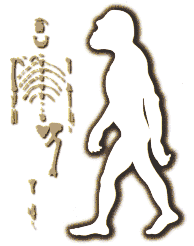 |
| Lucy: over 3 million years ago, she walked upright, stood about 1 metre tall, had an ape-like brain and possibly slept in the trees. She may even have been one of our ancestors. |
Up to three early toolmaking species lived in Africa around
this time, and one of these, known as H. ergaster, might be an early
form of Homo erectus, the next major player in the story of human
evolution.
The earliest fossils of this type are 1.8 million years old. H. erectus,
or "upright human", was tall, though with a flattened head, but would
probably not stand out too much in a crowd today. Their brains were larger
again than their predecessors, at about 900 cubic centimetres for adults.
Although the modern human brain averages around 1350 cubic centimetres, the
H. erectus brain is the first to fall within the normal range for
modern people.
The species H. erectus was a great traveller, and appears
to be the first of our recent ancestors to venture beyond Africa. Fossils
of this species, some of great age, have been found as far away from Africa
as China and Java. But archaeologists often depict the stone-tool culture
of H. erectus as one of monotonous regularity. Fairly soon after its
first appearance,H. erectus began making Acheulian hand axes -and
carried on making them for a million years. This multipurpose pear-shaped
tool, named after a French village where the axes were found, had two cutting
edges running to a point at one end and a rounded grip at the other end.
The maker took a suitably shaped stone and, in a carefully planned sequence,
knocked small flakes off it until it was the required shape. This was a
significant advance over the Oldowan tools, many of which were probably discarded
soon after being made. But the Acheulian hand axe required considerable skill
to make and was almost certainly carried around, and occasionally resharpened,
until it became unserviceable.
The similarity of these hand axes from sites throughout Africa,
Europe and Central Asia, and the obvious intention of the makers to have
very symmetrical shapes, suggests that the knapping skills would have needed
more than simple mimicry to learn. Perhaps, then, these tools are evidence
of the first lessons.
Does this mean that H. erectus could talk? The balance of opinion
is that if there were the beginnings of language, they did not amount to
much. Ann MacLarnon of the Roehampton Institute in Britain has studied the
spinal column of H. erectus , and concludes that it probably had none
of the fine control of the diaphragm that we need to propel air into the
larynx in complex bursts as we speak. An absence of language, or at least
its simplicity and lack of use in technical matters, might explain the very
slow rate of change in the stone tool technology.
The pelvis of H. erectus is so small that the newborn
brain would have been small, and the baby very dependent. But brain growth
in early postnatal life must have been rapid, a characteristic which has
been preserved in modern humans.
For about 500 000 years, African H. erectus shared the savannah with
robust australopithecines, before they died out. But the rapid spread of
people into Asia and Europe may have already begun. Some controversial dates
from Java suggest H. erectus was there soon after it appears in Africa.
But H. erectus had probably begun to migrate around million years
ago.
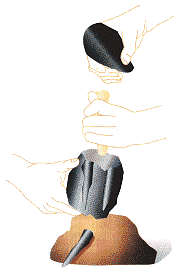 |
| Blade technology: developed by Homo sapiens, this required two stages, preparing the core, and striking off the blades. |
About 500 000 years ago, a new type of stone technique appears,
called the "prepared core" technique. First, a cylindrical core was
made by knocking flakes off the original lump of stone, much as the Acheuhan
hand axe was formed. But then, longer, thinner blades were struck off the
core, giving a variety of tools which were sharper and generally better fitted
for the tasks they had to perform.
Though preparation of the stone took longer, the new method produced a dramatic
improvement in the quality and quantity of the final tools. Archaeologists
have uncovered ancient stone workplaces, known as knapping floors, where
the tools were produced, and have been able to work out how they were made
by fitting discarded flakes back together again.
A second burst of growth in brain size was taking place too,
and fossils associated with the new stone technique are generally called
archaic H. sapiens. The larger brain was probably an evolutionary
advantage for social reasons as well as for technology. The ability to memorise
social relationships and cooperate in foraging and hunting are important
mental skills.
But the brain is energetically expensive. In modern
humans it is only 2 per cent of an adult's body mass but demands about 20
per cent of the body's total energy requirement. Leslie Aiello of University
College London and Wheeler have suggested that this high-energy uptake of
the brain must have been compensated for by a reduction in energy demand
elsewhere. Modern humans have smaller and less energy-demanding digestive
tracts than other primates, made possible by a shift away from vegetable
foods, and the use of cooking, which breaks down food prior to digestion
and destroys toxins.
In China, by 500 000 years ago,H. erectus appears to have used fire
in caves. Some limited use of fire may extend back much further, to one of
the earliest Homo species. But the evidence is inconclusive. Perhaps
the earlier Homo species could occasionally use fire taken from naturally
caused bush fires to keep predators away at night. And maybe the use of fire
for heating caves had been learned by H. erectus. But the earliest
evidence of a hearth, surrounded by stones, comes from Brittany around 430
000 years ago.
Europe went through a series of very cold spells around this time, and the
control of fire was probably essential for survival there. One group of humans,
the Neanderthals, who are found from 150 000 to 35 000 years ago,
became physically specialised for such conditions. They had large bodies,
and even bigger brains than modern humans. They used a slightly more advanced
prepared core technique, called the Mousterian. Their bones show that
they were very muscular, died young and suffered regular injuries. There
is some evidence that they cared for the sick, and may have buried their
dead, though apparently without much ceremony.
While the Neanderthals were adapting to the cold in Europe,
genuinely modern - looking humans were evolving in warmer climates. By 100
000 years ago, in the Middle East and the southernmost tip of Africa, some
fossils show the domed crania of modern humans.
Around 50 000 years ago, these modern humans underwent what archaeologists
have called a "cultural revolution". Unlike the Neanderthals, modern humans
developed a more advanced blade technology and created compound tools,
made of several interlocking parts of different materials. They constructed
huts out of mammoth tusks, stones or wood. They produced cave paintings,
buried their dead with grave ornaments, traded in shells, carved figurines,
and made music.
The Neanderthal sites show none of this new cultural activity.
But the two species lived side by side in Europe and the Middle East for
many thousands of years. The superior technique and culture of the modern
humans probably gave them an economic edge over the Neanderthals, who eventually
died out.
Artistic inclinations Cultural revolution
THERE is some doubt as to whether modern speech and language
arose at the time of the cultural revolution, and may even partly explain
it, or whether language had developed earlier. Some development of language
would certainly help to explain the cultural revolution.
These cultural humans probably came from Africa, and over the next 40 000
years they populated every part of the world, reaching the Americas some
time after about 14 000 years ago and surviving in the most extreme environments.
Populations grew rapidly, and began to deplete traditional
resources. Several game species became extinct, which was perhaps the spur
for humans to take up herding and planting.
Agriculture appears to have emerged independently in both the Near
East and Middle America, some time after 10 000 years ago. Humans increasingly
abandoned their ancient nomadic way of life, settled, built long-lasting
homes and cities and started to record their actions. This is where the
prehistory of our extraordinary species is said to end, and its history begins.
Are we still evolving? There are not many physical differences
between us and our ancestors of 50 000 years ago, and natural selection may
not be as severe now thanks to modern hygiene and medicine. But selection
is taking place, through differences in rates of population growth around
the world and within populations.
If we look back over our prehistory, it tells us something of what made us
human. In general we are clearly more dextrous, imaginative, talkative,
cooperative, long - lived, hygienic, parental, adventurous and safety-conscious
than our ape-like ancestors, who were similarly better at these things than
the mouselike ancestral mammals. If we can improve at these characteristics,
perhaps we can become even more human still.
|
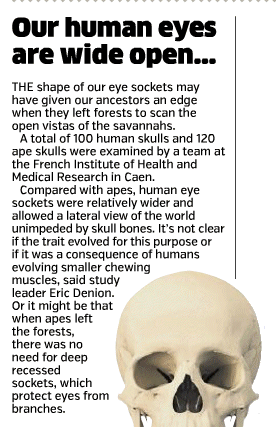 |
© Reed Business Information 1999. Educational
copying of Inside Science is permitted under licence of Copyright Licensing
Agency Limited, 33 - 34 Alfred Place, London WC1 7DP
Back numbers of Inside Science are available
from New Scientist, P.O. Box 666, London ElS 1DW. Inquiries 0181
5030589.

